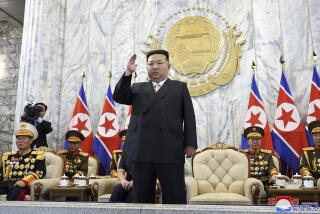China to parade its new and improved arsenal
- Share via
BEIJING — For the first time in a decade, Beijing on Thursday will showcase its latest armored vehicles, ballistic missiles and fighter jets in a demonstration of military ambition meant to befit the nation’s economic rise.
The display of hardware -- part of the government’s 60th anniversary celebrations -- will no doubt stoke national pride. But it’s also a chance for China to show an international audience that the world’s third-largest economy is investing heavily in military technology, a strategic sector that Beijing believes will strengthen its regional security and global influence.
Expected to be on display is a new generation of missiles that could potentially strike American naval ships and pound Taiwanese soil from the Chinese mainland. It is the product of two decades of enhanced military spending aimed at overhauling a woefully inefficient and technologically challenged fighting force.
“They have been focusing on catching up in areas where the technological disparity has been the greatest, and cultivating pockets of excellence within” the People’s Liberation Army, said David Yang, a political scientist at Rand Corp. “That said, the PLA is a massive, even ponderous, organization, and its professionalization and modernization will remain an arduous process for years.”
With 2.3 million members, the Chinese army is the largest standing army in the world. Beijing has spent years trying to overcome the army’s long-held image as a poorly equipped force consisting mostly of rural enlistees. The army lacks combat experience, having last engaged in a major conflict in 1979 with Vietnam.
Earlier this year, officials announced heavy recruitment of college graduates. More important, Beijing has increased military spending each year by double-digit percentages. China’s official military budget was $70.3 billion this year, up sharply from $14.6 billion in 2000, according to Washington-based GlobalSecurity.org.
Chinese state media have trumpeted the fact that almost all the new weaponry to be unveiled at the parade was domestically produced, a major leap from the days when China was almost totally reliant upon the Soviet Union for sophisticated armaments. China’s fighting capabilities were not nearly as advanced 10 years ago, the last time the country celebrated its national anniversary with a military parade.
“This year’s display should signal a more balanced relationship between military might and economic development with the showing off of a range of new equipment that is at least one to two generations more advanced,” said Tai Ming Cheung, a Chinese military expert at UC San Diego.
Regional powers including Japan, South Korea and India are undoubtedly paying attention. China’s military policy traditionally has been focused on preventing Taiwan from achieving formal independence. But China has become an active weapons exporter, and watchdogs including Amnesty International have criticized it for supplying arms to countries with poor human rights records such as Sudan and Myanmar.
With its expansion onto the global stage, China feels more empowered to secure its borders and defend its shipping routes carrying oil supplies, analysts said. Beijing has also bristled at American surveillance activity off its coast, resulting in standoffs this year.
“A threat is really two parts: capability and intentions,” said Mark Stokes, executive director of the Project 2049 Institute, which promotes international security. “We’re learning about China’s capability. Intentions are not clear at this point.”
Chinese military officials have sought to downplay suggestions that the country is engaging in saber rattling by parading its military arsenal.
“A country’s military ability is not a threat to anyone. What is important is its military policy,” Gen. Gao Jianguo said.
Part of that growing ability to be showcased will be the Dong Hai 10 cruise missile, a land attack weapon; the Dong Feng 31, an intercontinental ballistic missile capable of hitting Washington with a nuclear warhead; and the Dong Feng 21, designed in part to be able to knock out U.S. ships defending Taiwan.
In total, 108 missiles are scheduled to roll past the rostrum at Tiananmen Square during the 66-minute parade. They will be complemented by 5,000 soldiers and 150 aircraft, including an “early warning and control” aircraft to detect enemy planes, as well as China’s latest-generation J-10 fighter jets.
The technology has proved to be a moneymaker, leading some observers to believe the showcase involves an element of marketing. China sold $264 million worth of its military aircraft last year to allies such as Pakistan, according to the Stockholm International Peace Research Institute.
China was the world’s ninth-largest arms exporter last year, with $468 million in sales, according to the institute. That pales in comparison with the $6.1 billion sold by the U.S. in 2008. China’s sales could be higher, however, because of unreported sales of arms and military technology.
Over the summer, residents of Beijing were given a preview of this week’s parade. Streets were periodically shut down and some pockets of airspace temporarily closed to commercial aircraft to allow tanks, planes and helicopters to rehearse.
On a recent weekday, Zhuang Yu, a 21-year-old tourist from Shaanxi province, was watching video of past military parades at a Chinese Communist Party memorabilia store located at the entrance of a public toilet at the southwest end of Tiananmen Square.
“The news of this year’s parade makes you feel like the country is becoming stronger,” she said. “Maybe foreigners get nervous when they see so many soldiers and tanks. But I think it makes most Chinese feel safer.”
--
Tommy Yang in The Times’ Beijing bureau contributed to this report.
More to Read
Sign up for Essential California
The most important California stories and recommendations in your inbox every morning.
You may occasionally receive promotional content from the Los Angeles Times.











